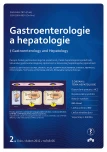Analysis of volatile compounds in the breath of patients with inflammatory bowel diseases
Authors:
Luděk Hrdlička 1; K. Dryahina 2; D. Ďuricová 1; M. Bortlík 1; N. Machková 1; P. Španěl 2; M. Lukáš 1,3
Authors‘ workplace:
Klinické a výzkumné centrum pro střevní záněty, ISCARE Lighthouse a 1. LF UK v Praze
1; Ústav fyzikální chemie J. Heyrovského, AV ČR
2; Ústav klinické biochemie a laboratorní diagnostiky, 1. LF UK v Praze
3
Published in:
Gastroent Hepatol 2012; 66(2): 125-130
Category:
IDB: Original Article
Overview
Introduction:
All tests currently used in clinical diagnostics and the activity monitoring of inflammatory bowel disease (IBD) have limited sensitivity and specificity or are directly linked to discomfort or risk to the patient (endoscopy or repeated CT tests), therefore necessitating new, non-invasive methods. The quantification of volatile metabolites in breath is a potential biomarker of IBD presence and activity. Selected ion flow tube mass spectrometry (SIFT-MS) is a relatively new analytical technique for quantitative analysis of the trace gases, chiefly in human breath.
Methods and subjects:
In our pilot project, SIFT-MS was used for the analysis of volatile IBD biomarkers in breath. Differences in their concentrations were studied in relation to the presence of IBD and activity of the disease. The study sample was composed of 48 IBD patients, 28 with ulcerative colitis (UC) and 20 with Crohn’s disease (CD). Of the 48 patients, 25 were female and 23 male. The mean age was 30 years and the mean disease duration was 10 years.
Results:
Significant differences between subgroups of patients were found in the concentrations of pentane, carbon disulphide, acetone and propanol. Patients with CD (both with active and quiescent disease) had significantly higher concentrations of pentane compared to the group of healthy individuals (115 vs. 61 nmol/mol; p < 0.01), as was the case for patients with active UC (91 vs. 61 nmol/mol; p < 0.01). The concentration of carbon disulphide (H2S) was significantly higher in patients with active CD (111 vs. 50 nmol/mol; p < 0.01) and concentrations of acetone (1,495 vs. 509 nmol/mol; p < 0.01) and propanol were significantly higher in the breath of patients who had undergone colonoscopy prior to breath analysis (this was likely due to a lack of nutrition).
Conclusions:
Based on the results of this study, we consider the use of breath testing using SIFT-MS to be a beneficial non-invasive diagnostic and monitoring method for IBD activity. Further targeted studies are necessary to address this issue.
Key words:
inflammatory bowel disease – biomarkers –volatile organic compounds – breath analysis – selected ion flow tube mass spectrometry – SIFT-MS
Sources
1. Lukas M, Bortlik M, Maratka Z. What is the origin of ulcerative colitis? Still more questions than answers. Postgrad Med J 2006; 82(972): 620–625.
2. Hanauer SB, Sandborn WJ, Rutgeerts P et al. Human anti-tumor necrosis factor monoclonal antibody (adalimumab) in Crohn's disease: the CLASSIC-I trial. Gastroenterology 2006; 130(2): 323–332.
3. Kirsner J, Sartor R, Sandborn W. Kirsner's inflammatory bowel diseases 6-th edition. Edtion ed.: Saunders 2004.
4. Kokoszka J, Nelson RL, Swedler WI et al. Determination of inflammatory bowel-disease activity by breath pentane analysis. Dis Colon Rectum 1993; 36(6): 597–601.
5. Ondrula D, Nelson RL, Andrianopulos G et al. Quantitative-determination of pentane in exhaled air correlates with colonic inflammation in the rat colitis model. Dis Colon Rectum 1993; 36(5): 457–462.
6. Bodlier A, Pierik MJ, Dallinga JW et al. Analysis of Volatile Organic Compounds in Exhaled Air As a Non Invasive Biomarker for Inflammatory Bowel Disease (IBD). Gastroenterology 2009; 136(5): A35.
7. Sedghi S, Keshavarzian A, Klamut M et al. Elevated breath ethane levels in active ulcerative-colitis – evidence for excessive lipid-peroxidation. Am J Gastroenterol 1994; 89(12): 2217–2221.
8. Pelli MA, Trovarelli G, Capodicasa E et al. Breath alkanes determination in ulcerative colitis and Crohn's disease. Dis Colon Rectum 1999; 42(1): 71–76.
9. Probert CSJ, Ahmed I, Khalid T et al. Volatile Organic Compounds as Diagnostic Biomarkers in Gastrointestinal and Liver Diseases. J Gastrointestin Liver Dis 2009; 18(3): 337–343.
10. Smith D, Spanel P. Selected ion flow tube mass spectrometry (SIFT-MS) for on-line trace gas analysis. Mass Spectrom Rev 2005; 24(5): 661–700.
11. Spanel P, Smith D. Progress in SIFT-MS; breath analysis and other applications. Mass Spectrom Rev 2011; 30(2): 236–267.
12. Amann A, Smith D. Breath Analysis for Clinical Diagnosis and Therapeutic Monitoring. In. Singapore: World Scientific 2005: 536.
13. Smith D, Spanel P. The challenge of breath analysis for clinical diagnosis and therapeutic monitoring. Analyst 2007; 132(5): 390–396.
14. Miekisch W, Schubert JK, Noeldge--Schomburg GFE. Diagnostic potential of breath analysis – focus on volatile organic compounds. Clin Chim Acta 2004; 347(1–2): 25–39.
15. Tasspou CN, Barnett D, Fraser TR. Breath-acetone and blood-sugar Measurements in diabetes. Lancet 1969; 1(7609): 1282–1286.
16. Turner C, Spanel P, Smith D. A longitudinal study of ammonia, acetone and propanol in the exhaled breath of 30 subjects using selected ion flow tube mass spectrometry, SIFT-MS. Physiol Meas 2006; 27(4): 321–337.
17. Hibbard T, Killard AJ. Breath Ammonia Analysis: Clinical Application and Measurement. Critical Reviews in Analytical Chemistry 2011; 41(1): 21–35.
18. Gustaffson LE, Leone AM, Persson MG et al. Endogenous nitric oxide is present in the exhaled air of rabbits, guinea pigs and humans. Biochem Biophys Res Commun 1991; 181(2): 852–857.
19. Sachs-Olsen C, Carlsen KCL, Mowinckell P et al. Diagnostic value of exhaled nitric oxide in childhood asthma and allergy. Pediat Allergy and Immunol 2010; 21(1): E213–E221.
20. Spanel P, Smith D. Selected ion flow tube: A technique for quantitative trace gas analysis of air and breath. Med Biol Eng Comput 1996; 34(6): 409–419.
Labels
Paediatric gastroenterology Gastroenterology and hepatology SurgeryArticle was published in
Gastroenterology and Hepatology

2012 Issue 2
Most read in this issue
- Hepatorenal syndrome in patients with acute alcoholic hepatitis
- Current approach to anaemia in patients with inflammatory bowel disease
- Treatment of achalasia – the current approach and personal experience
- Prof. Jiří Nevoral on the occasion of his 70th birthday
